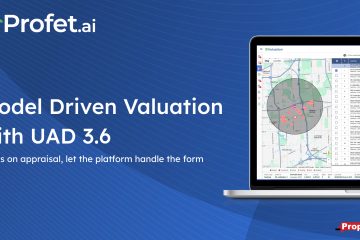The standards of real estate appraisal in the US includes 3 major methods for appraising the value of a real estate property – sales comparison approach, cost approach, and the income approach. Of the three the sales comparison approach is most commonly used for appraisals and is also included in appraisals of investment properties where the income approach may be better suited. While a complete appraisal does take into account various other aspects of the subject property such as neighborhood conformance, condition, highest and best use, etc. the foundational value derived from the sales comparison approach plays a huge role in the final value determination.
As a result, it is important for chief appraisers at AMCs and lenders to ensure the below aspects of the sales comparison approach are accurate, consistent, and complete.
- Selection of the best comparable properties for the subject property
- Calculation of adjustments to the comparable properties
- Ensuring objectivity and eliminating bias in the comparable selection process
- Highest and best use of the comparable property is the same as of the subject
We will review each of these topics in the upcoming posts starting with the first one here.
Selection of the best comparable properties
The foundation of the sales comparison approach in creating an appraisal is the selection of the comparables. Like the saying “garbage-in, garbage-out”, if the comparables selected are not really close enough to the subject property then, none of the adjustments we make to the comparables will result in a reliable value for the subject.
So, how do we validate that the best available comparable properties have been used. Note the key phrase – “best available comparable properties”. We can only use properties that were recently sold – in the last 12 to 18 months, in the area of the subject property and so it is also reasonable to arrive at a conclusion that there are no good recent sales available. Such a conclusion would indicate that the only option is to look at alternative valuation approaches.
Assessing the quality of the comparables used in an appraisal is laborious and time consuming - but understanding transactional and property adjustments lends a starting point.
Where do we start to review the comparables?
There is a lot of information in a 30-plus page appraisal document that is covers a lot of ground. If you do this manually, you will first need to review the subject property information in detail, internalize the subject information and then start reviewing each comparable on the comp grid to see how it fits.
But there is a quick way to get started using the adjustments in the comp grid. Before we get into that let us get on the same page with some terminology.
Broadly there are 2 types of adjustments: Transactional Adjustments and Property Adjustments. Transactional adjustments refers to adjustments that are typically made to the whole sale price and represent elements of the transaction such as date of sale, financing concessions, seller concessions, or property rights conveyed. On the other hand property adjustments are made as a result of comparing the property characteristics between the comparable and the subject and are applied to the units of comparison.
When assessing the relevance of comparables with respect to the subject property, it is important to separate out the property adjustment totals because they really represent a comparison of the characteristics as opposed to the transactional adjustments. The following bullet points refer only to property adjustments.
Gross Property Adjustments is the total of the absolute values of all the adjustments applied to a comparable. An absolute value means that we convert all positive or negative adjustment values to a positive number before adding them. See the example below. Gross Property Adjustments for a comparable represents the overall difference between the subject and the comparable. If the gross property adjustment on a comparable property is too high, it is an indication that comparable is too different from the subject. In general a gross adjustment percentage of 25% or higher is considered too high.
Net Property Adjustments is the total of the raw values of the adjustments applied to a comparable. Net Property Adjustments for a comparable represents the effective difference between the subject and comparable. In other words what is left in balance after accounting for characteristics that are superior or inferior than the subject. If the net adjustment on a comparable is very high – generally more than 15% of the sale price of the comparable, it could indicate that the property is too dissimilar to the subject property.
Here is an example of Gross and Net Property Adjustments. Consider the following grid assuming the current date is June 2023.
Subject | Comparable Sale #1 | ||
Address | 123, Main St | 234, Park St | |
Proximity to Subject | 0.8 miles SW | ||
Sale Price | $395,000 | ||
Transactional Adjustments | Description | Description | Adjustment |
Sale or Financing Concessions | Conventional Loan $5,000 sale concess. | -$5,000 | |
Date of Sale | Oct 10, 2022 | +$4,500 | |
Property Rights | Fee Simple | Fee Simple | |
Property Adjustments | Description | Description | Adjustment |
Location | Residential | Residential | |
Site | 11,000 sf | 14,500 sf | -$35,000 |
Bedrooms | 5 | 4 | $11,000 |
Living Area | 2,900 sf | 3,200 sf | -$40,800 |
Here are the adjustment numbers we can derive for comparable sale #1 from the above example:
Amount | Percentage of Sale Price | |
Total Gross Adjustments | $96,300 | 24.38% |
Total Net Adjustments | -$65,300 | 16.53% |
Gross Transactional Adjustments | $9,500 | 2.41% |
Net Transactional Adjustments | $500 | 0.13% |
Gross Property Adjustments | $86,800 | 21.97% |
Net Property Adjustments | -$64,800 | 16.41% |
If you notice the Gross or Net Property Adjustments are above their thresholds that could be the first sign that we may not have the best comparables selected.
But then, if we only consider the adjustments provided by the appraiser we are implicitly relying on the quality of the adjustments made. In other words, the unit values used for the adjustments may not be correct after all. For example, the appraiser could have used a different per bedroom value for 2 different comparable properties which may result in low adjustment values. Or an adjustment may be missing altogether for a property, even though these are typically caught by the forms software used by the appraiser.
Gross Property Adjustments greater than 25% or Net Property Adjustments greater than 15% of the comparable sale price is an indicator of sub-optimal comparable selection.
So, very soon you can see that doing all these calculations manually can be cumbersome to say the least and very time consuming and error prone. So, an appraisal review software would catch these types of errors easily and provide a report to help the reviewer.
On the other hand a better appraisal software would also recommend the comps more similar to the subject that the appraiser might have missed. This requires the review software to have access to the sales in that local market and apply machine learning techniques to find the best comps for the subject by looking at all the property characteristics that contribute to a property’s value in the market we are researching.
In future articles, we will address additional elements of comparable analysis and also discuss how it can be achieved using efficient review software.
Reference: “The Appraisal of Real Estate”, 14th Edition. Published by the Appraisal Institute.



